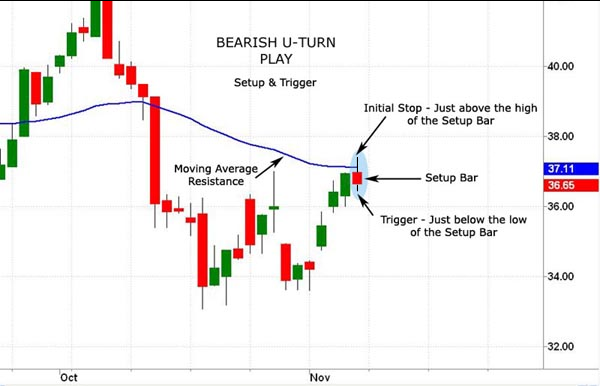The “Bearish U-Turn”
Similar to the Bullish Bounce, this stock trade looks for a strong trend. However, instead of an upward, bullish trend, the Bearish Setup looks for a downward price trend. Once the trend is confirmed, we wait for a normal rise to take prices back up to a selected moving average, which serves as resistance. Just as in the Bullish bounce, the criteria for “normal rise” includes the distance the stock rises in proportion to price, and the length of time it takes to complete the move up to the chosen resistance.
The most important aspect of a Bearish U-Turn set-up is determined by how the stock price reacts when it comes in contact with the resistance level, the specific moving average. The preferred reaction takes place when the stock rises to the resistance level during intra-day trading, then reverses and moves down a certain percentage of the day’s high-to-low range.
Once the “Bearish U-Turn” Setup is in place, we watch for a confirming sign that the previous downward trend is about to resume. This is usually a stock price move that takes out a short-term technical support level, such as the low of the Set-up day. This move will normally occur within a day or two after the Set-up day. The move is our signal to immediately place an order to sell the stock short. Once a position is entered, we always place an Initial Stop for protection, and then follow up with a Trailing Stop as the stock trade moves favorably.
Here is an example of a Bearish U-Turn Play setup:

A positive aspect of the Bearish U-turn is the tendency for the stock price to gain momentum as it moves away from the point of entry. These trades often become positive very quickly, allowing the initial stop to be moved to the break-even level. At this point the position essentially becomes a “free” trade with no risk of loss – as long as the stop is only moved in the direction of the profit.
